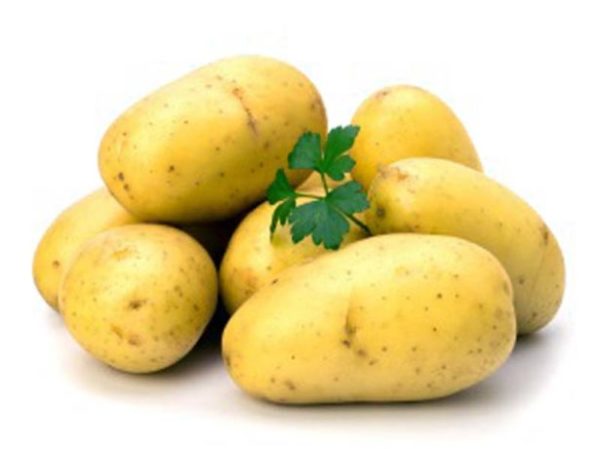
Today we will talk about potatoes of the Colette variety (description, photo, reviews see below), in our country it has been grown for more than 15 years. Vegetable growers fell in love with Colette for their high yield, resistance to diseases and short ripening, which is especially important for the North Caucasus region.The description of the Colette potato variety mentions that it can be grown twice a season. In regions with a warm climate, this is certainly true, but in the suburbs or in the middle lane, you will have to use a greenhouse or hotbeds to get a double crop for the season. In general, the variety is popular with both private traders and farmers.
Content
Grade description
The bush of this variety is erect, of medium height. The green leaves are small, with slightly pronounced waviness along the edges. The flowers are large with a red-violet hue, they look beautiful. Colette tubers are elongated - oval in shape, with a yellow, smooth peel and small eyes. The pulp is light yellow. Tuber weight from 120 to 123 g.
Grade characteristics
Colette refers to early ripening varieties, the crop is harvested on the 45th day after emergence. At this time, from one hundredths you can get from 110 to 150 kg. If you wait 10 days, the crop will add in weight from 160 to 280 kg. Keeping quality is high up to 92%. The starch content in tubers is from 12 to 15%. The peculiarity of the Colette variety is that the tubers do not boil during cooking. Potatoes are suitable for most dishes, including chips.
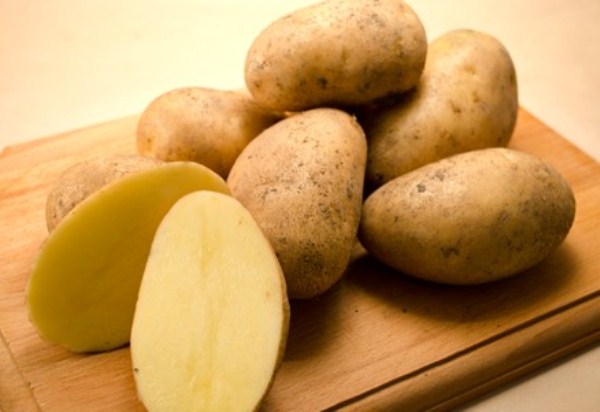
The Colette variety is resistant to late blight and is not affected by the cyst-forming nematode and potato cancer.
The main advantages of the variety:
- excellent germination;
- friendly return;
- early variety (ripening in 45 days, there is the possibility of re-cultivation in the southern regions, Moscow region and the middle lane);
- good keeping quality of the crop 97%;
- high transportability (tubers tolerate transportation well even over long distances);
- resistance to a number of major diseases;
- flat tuber shape suitable for industrial processing.
Landing time
Depending on the weather conditions of the regions, the time for planting potatoes is different. It is important that the soil warms up to +10 degrees, and is sufficiently moist. Knowing the ripening time of potato Collet can independently determine the date of planting.
How to plant
Germination. Three weeks before planting, seed potatoes are brought into a warm room at a temperature in which should be around +20 ° C and humidity 80%. After a few days, the temperature indicators are reduced to +10 ° C, this helps the formation of strong sprouts.
The processing of tubers. This event is carried out in order to protect the seed from insect pests and certain diseases. For the treatment of tubers, the following preparations are used: Prestige, Maxim, Cruiser, Albit.
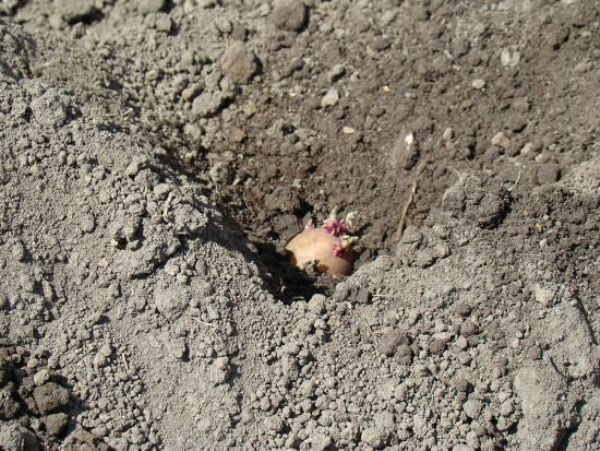
Site selection. Potato beds are located in open sunny places, away from the occurrence of groundwater. Good precursors for potatoes are peas, beans, dill, basil, mustard (used as siderat), beets, peppers.
Landing. Tubers of the Colette variety are planted in holes or grooves with the obligatory addition of a handful of wood ash and humus (0.5 liters). The depth of seed placement on light soils is 12 cm, on loamy and peaty soil 6-7 cm. 35 cm are left between tubers and 60-70 cm between rows.
Care
Watering. The Colette variety needs moisture. The first time the plantings are watered as soon as the shoots appear. A second watering is required during the formation of the buds, a third time the potatoes are watered after flowering, at this time there is an increased growth of tubers. If there is intense heat for three or more days, the plants need to be watered.
Loosening and weeding are also mandatory components of the care of potato plantings. The soil is loosened after precipitation in the row-spacings to a depth of 3-4 cm. Weed plants must be removed, as they attract harmful insects. For example, a weed like wheatgrass, or rather its succulent roots, uses a nutcracker bug to lay larvae. Subsequently, they make numerous moves in the potato tubers.
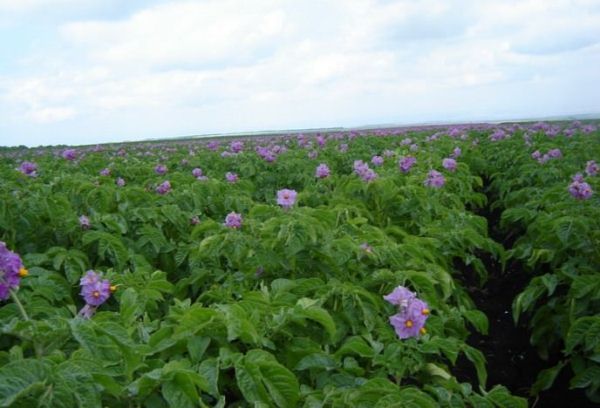
Hilling. This technique helps to increase tuber formation, and also increases the nutritional area of the plant. Hilling is carried out on moist soil. The first time it is necessary to do this, as soon as a young bush of potatoes grows 10-12cm. The second time they spud plants after 14 days. Do this by raking the soil to the plant stem from all sides.
Top dressing. For the Colette variety, additional nutrition is required. At the stage of culture growth, if the foliage is pale in color and the stems are thin, they are fed with urea or Effekton. During the formation of buds, plants can be fed with wood ash (50 g under the bush during hilling) or potassium sulfate. The last fertilizer application is carried out at the flowering stage. For this, use superphosphate per 10 liters of water, three tablespoons of fertilizer. The resulting solution is used in a proportion of 1 liter for each plant.
Diseases and Pests
Since the variety is not affected by major diseases, for preventive purposes, plantings are treated once during intensive growth. To do this, use one of the following drugs: "Polyram", "Kurzat", "Khom", "Ordan".
Pests:
- Colorado potato beetle, lays hundreds of yellow eggs on the back of the leaves, of which in a few days larvae appear that feed on green leaves. From these insects, they are treated with Prestige, Masterpiece, Batsikol;
- the wireworm or the larva of the nutcracker bug, spoils the potatoes, making moves in them. In the spring a week before planting potatoes, special traps for wireworms are placed on the beds. It is very simple to make them; for this, plastic cups made from sour cream are suitable. They are filled with potato peelings and dug at ground level. After a few days, hungry larvae will surely slip into the bait, it remains only to destroy them.
- Another common pest is potato moth. She lays eggs on the petioles of potato leaves, from which caterpillars will soon be hatched. They very quickly destroy the entire green mass and can even taste the tubers close to the surface of the earth. Caterpillars are destroyed by Spark, and in order to prevent their appearance, pheromone traps are installed next to the beds, they can be purchased at any garden store.
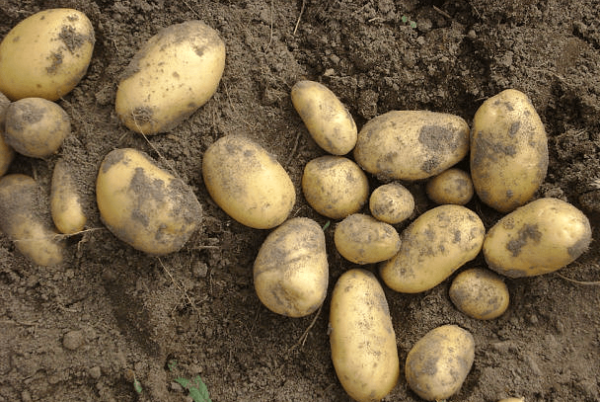
Harvesting and storage
Harvesting potatoes of this variety can be done manually or using equipment. Drying potato tops are a sure sign for harvesting. Dripping potatoes in fine sunny weather. Dug up tubers leave for a couple of hours for ventilation. Next, the potatoes are sorted, removing damaged tubers. Harvest transported to storage in the cellar. To preserve potatoes until spring, it is necessary to observe a temperature of no more than + 2 degrees and a humidity of about 80%.
Grade Reviews
Tamara, 46 years old:
“Potato Colette liked its productivity, large tubers of the same size, without depressions, so it’s easy to peel. This variety is well suited for salads, as it is not digested. A special taste opens when frying, because it is not for nothing that the variety is recommended for making chips. ”
George, 41 years old:
“The variety was planted on loamy soil, but he had previously brought humus and wood ash when digging the site, and the crop was good. For food, they began to dig potatoes about 45 days after germination. ”
Sergey, 35 years old:
“We grow Potato Colette for the fifth season, in general we are satisfied with the harvest, during this time I changed the seeds once. The plants did not hurt, only the Colorado potato beetle attacks from pests. Despite the fact that the variety is early, the crop is perfectly stored until spring. "




 Description and description of varieties in Belarus with a photo
Description and description of varieties in Belarus with a photo Do I need to pick flowers from potatoes: why do they do it
Do I need to pick flowers from potatoes: why do they do it When to dig potatoes: timing and availability of new potatoes
When to dig potatoes: timing and availability of new potatoes How to grow a good potato crop: various methods and methods, planting and care
How to grow a good potato crop: various methods and methods, planting and care